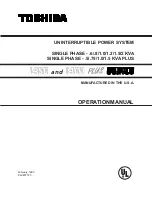
19
MAKE SURE GROUNDING IS PROPERLY DONE!
◆
Set the Battery Breaker to the “ON” position according to the user’s manual.
◆
Open the front and rear doors of the UPS to access to the main power switches.
During this procedure the output terminals will become alive.
CAUTION
!
Check to see if the load is safely connected with the output of the UPS. If the
load is not ready to receive power from the UPS, make sure that it is safely
isolated from the UPS output terminals
◆
Turn ON
the bypass and input switches of the UPS, make sure that “fuse box” insert the
cabinet, and
fix with screws
When AC MAINS input voltage within the range, And the rectifiers of the UPS will be started
up in 30 seconds, then the inverter is started completely. When the output breaker is “ON”, the
inverter LED lights up.
◆
Switch ON output breaker
If the rectifier of the module does not start-up, the bypass LED will light up.
When the inverter is on, the UPS will transfer from bypass mode to inverter mode,
then the bypass LED is off and the inveter LED is on.
No matter the UPS is operated normally or not, the LCD display will indicate
current status.
4.2.2 Test procedure
CAUTION!
The UPS is operating normally.
It may take 60 seconds to boost up the system and perform self-test completely.
◆
Switch off the MAINS to simulate utility failure, the rectifier will turn off and the battery
should feed the inverter without interruption. At this time, the LEDs of battery should be
turned on
.
◆
Switch on the MAINS to simulate utility recovery, the rectifier will restart automatically
after 20 seconds and the inverter will supply to the load. It is suggested to use Dummy
loads for testing. The UPS can be loaded up to its maximum capacity during load test
。
4.2.3 Black(Cold) start procedure
















































